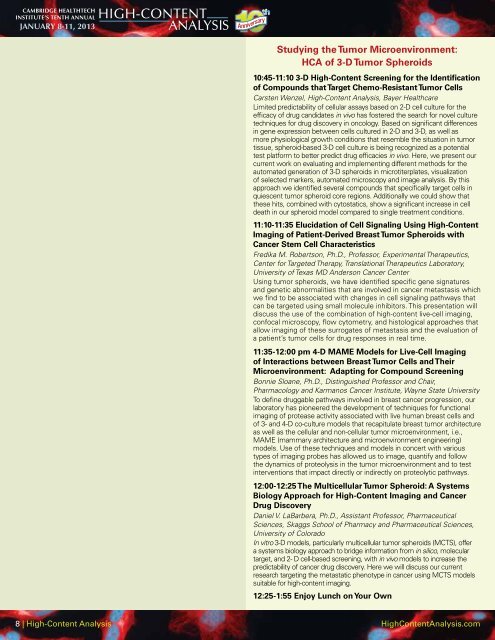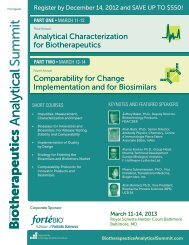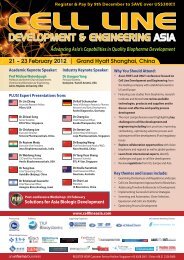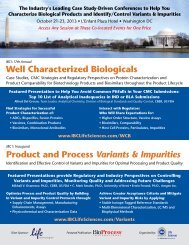HigH-Content AnAlysis
HigH-Content AnAlysis
HigH-Content AnAlysis
You also want an ePaper? Increase the reach of your titles
YUMPU automatically turns print PDFs into web optimized ePapers that Google loves.
Cambridge Healthtech<br />
Institute’s TENTH Annual<br />
January 8-11, 2013<br />
High-<strong>Content</strong><br />
Analysis<br />
Anniversary<br />
Studying the Tumor Microenvironment:<br />
HCA of 3-D Tumor Spheroids<br />
10:45-11:10 3-D High-<strong>Content</strong> Screening for the Identification<br />
of Compounds that Target Chemo-Resistant Tumor Cells<br />
Carsten Wenzel, High-<strong>Content</strong> Analysis, Bayer Healthcare<br />
Limited predictability of cellular assays based on 2-D cell culture for the<br />
efficacy of drug candidates in vivo has fostered the search for novel culture<br />
techniques for drug discovery in oncology. Based on significant differences<br />
in gene expression between cells cultured in 2-D and 3-D, as well as<br />
more physiological growth conditions that resemble the situation in tumor<br />
tissue, spheroid-based 3-D cell culture is being recognized as a potential<br />
test platform to better predict drug efficacies in vivo. Here, we present our<br />
current work on evaluating and implementing different methods for the<br />
automated generation of 3-D spheroids in microtiterplates, visualization<br />
of selected markers, automated microscopy and image analysis. By this<br />
approach we identified several compounds that specifically target cells in<br />
quiescent tumor spheroid core regions. Additionally we could show that<br />
these hits, combined with cytostatics, show a significant increase in cell<br />
death in our spheroid model compared to single treatment conditions.<br />
11:10-11:35 Elucidation of Cell Signaling Using High-<strong>Content</strong><br />
Imaging of Patient-Derived Breast Tumor Spheroids with<br />
Cancer Stem Cell Characteristics<br />
Fredika M. Robertson, Ph.D., Professor, Experimental Therapeutics,<br />
Center for Targeted Therapy, Translational Therapeutics Laboratory,<br />
University of Texas MD Anderson Cancer Center<br />
Using tumor spheroids, we have identified specific gene signatures<br />
and genetic abnormalities that are involved in cancer metastasis which<br />
we find to be associated with changes in cell signaling pathways that<br />
can be targeted using small molecule inhibitors. This presentation will<br />
discuss the use of the combination of high-content live-cell imaging,<br />
confocal microscopy, flow cytometry, and histological approaches that<br />
allow imaging of these surrogates of metastasis and the evaluation of<br />
a patient’s tumor cells for drug responses in real time.<br />
11:35-12:00 pm 4-D MAME Models for Live-Cell Imaging<br />
of Interactions between Breast Tumor Cells and Their<br />
Microenvironment: Adapting for Compound Screening<br />
Bonnie Sloane, Ph.D., Distinguished Professor and Chair,<br />
Pharmacology and Karmanos Cancer Institute, Wayne State University<br />
To define druggable pathways involved in breast cancer progression, our<br />
laboratory has pioneered the development of techniques for functional<br />
imaging of protease activity associated with live human breast cells and<br />
of 3- and 4-D co-culture models that recapitulate breast tumor architecture<br />
as well as the cellular and non-cellular tumor microenvironment, i.e.,<br />
MAME (mammary architecture and microenvironment engineering)<br />
models. Use of these techniques and models in concert with various<br />
types of imaging probes has allowed us to image, quantify and follow<br />
the dynamics of proteolysis in the tumor microenvironment and to test<br />
interventions that impact directly or indirectly on proteolytic pathways.<br />
12:00-12:25 The Multicellular Tumor Spheroid: A Systems<br />
Biology Approach for High-<strong>Content</strong> Imaging and Cancer<br />
Drug Discovery<br />
Daniel V. LaBarbera, Ph.D., Assistant Professor, Pharmaceutical<br />
Sciences, Skaggs School of Pharmacy and Pharmaceutical Sciences,<br />
University of Colorado<br />
In vitro 3-D models, particularly multicellular tumor spheroids (MCTS), offer<br />
a systems biology approach to bridge information from in silico, molecular<br />
target, and 2- D cell-based screening, with in vivo models to increase the<br />
predictability of cancer drug discovery. Here we will discuss our current<br />
research targeting the metastatic phenotype in cancer using MCTS models<br />
suitable for high-content imaging.<br />
12:25-1:55 Enjoy Lunch on Your Own<br />
8 | High-<strong>Content</strong> Analysis High<strong>Content</strong>Analysis.com

















